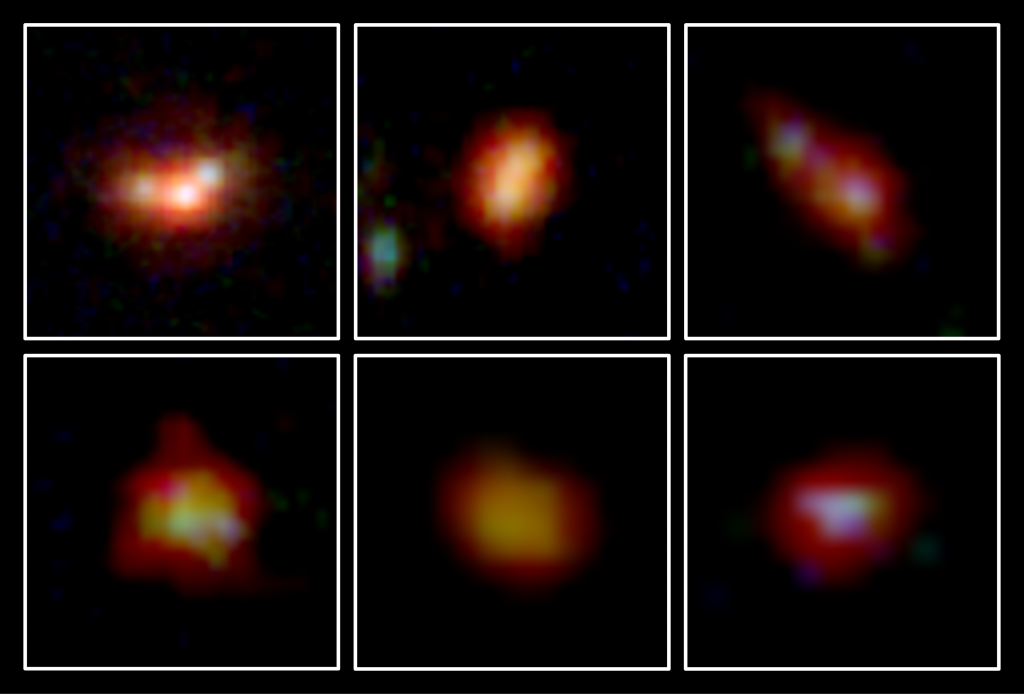Institute for cosmic Ray Research, The University of Tokyo
The National Astronomical Observatory of Japan

Using extensive observational data from the James Webb Space Telescope (JWST), a research team led by Project Assistant Professor Kimihiko Nakajima of the National Astronomical Observatory of Japan has examined the oxygen abundance (*) in galaxies dating back approximately 13.3 billion years, roughly 500 million years after the birth of the universe. Their pioneering findings reveal a remarkable increase in oxygen abundance in galaxies during the first 500-700 million years of the universe’s existence, approximately 13.1-13.3 billion years ago.
This discovery sheds light on the fascinating process through which essential oxygen, crucial for Earth and life as we know it, was produced from the inception of the universe until the present day.
In the early universe, shortly after the Big Bang, only light elements such as hydrogen, helium, or lithium existed. Heavier elements like oxygen were subsequently formed through nuclear fusion reactions within stars and dispersed into galaxies, primarily through events like supernova explosions. This ongoing process of element synthesis, unfolding over the vast expanse of cosmic history, is believed to be responsible for the creation of the diverse elements that constitute both our existence and the world around us.
Dr. Kimihiko Nakajima, the team’s spokesperson, emphasizes, “Unraveling the history of element evolution is one of the foremost intellectual pursuits in tracing the origins of the substances that constitute our existence.”
By observing the gas within galaxies, which are vast collections of stars, across cosmic distances, researchers can determine the abundance of oxygen in the ancient universe. Previous observations had already revealed the presence of abundant oxygen in galaxies approximately 2 billion years after the Big Bang (approximately 12 billion years ago). However, the light from galaxies that existed even further back in time is significantly affected by the universe’s expansion, causing it to shift into the near-infrared range. This shift presents a considerable observational challenge.
The research team utilized spectroscopic data from the Near-Infrared Spectrograph (NIRSpec) on JWST, which commenced scientific operations in 2022. They achieved the identification of 138 ancient galaxies that existed over 12 billion years ago and determined their oxygen abundances. This level of analysis was nearly impossible prior to the launch of JWST.
They developed and rigorously applied advanced analysis techniques to the JWST/NIRSpec data, conducting analyses on a scale several-10 times larger than previous studies. The results revealed that galaxies, spanning from the present to approximately 13.1 billion years ago, exhibited little evolution in oxygen abundance when compared to the average of galaxies with similar properties, such as stellar mass.
However, a significant discovery emerged among the most distant galaxies: among the seven galaxies discovered from 13.1-13.3 billion years ago, all seven displayed an oxygen abundance level of roughly half or less than expected. For six of the 7 galaxies, there was a 95% or higher probability of a deficit of oxygen abundance. Nakajima emphasizes, “This demonstrates a dramatic increase in the abundance of oxygen in galaxies during the first 500-700 million years aRer the birth of the universe.”
Prof. Masami Ouchi, a member of the research team from the National Astronomical Observatory of Japan and the Institute for Cosmic Ray Research at the University of Tokyo, remarks, “The process of how oxygen was created and stored in galaxies has long puzzled scientists. The discovery of a rapid increase in oxygen abundance in the early universe, approximately 13.1 to 13.3 billion years ago, suggests that life in the universe might have emerged earlier than previously believed.”
This research result is scheduled to be published in the Astrophysical Journal Supplement Series on November 13, 2023 under the title “JWST Census for the Mass-Metallicity Star Formation Relations at z = 4-10 with Self-consistent Flux Calibration and Proper Metallicity Calibrators.”
The members of the research team who conducted this study are as follows: Kimihiko Nakajima (National Astronomical Observatory of Japan), Masami Ouchi (National Astronomical Observatory of Japan / University of Tokyo), Yuki Isobe (University of Tokyo), Yuichi Harikane (University of Tokyo), Yechi Zhang (National Astronomical Observatory of Japan), Yoshiaki Ono (University of Tokyo), Hiroya Umeda (University of Tokyo), and Masamune Oguri (Chiba University).
This research was supported by the Japan Society for the Promo<on of Science (JSPS) KAKENHI Grants(No. JP19H00697, JP20H00180, JP20K22373, JP21H04467, JP21J20785, JP21K13953).
(*) Oxygen abundance refers to the ra<o of the number of oxygen (O) to that of hydrogen (H), denoted as (O/H). Hydrogen, being an element present since the birth of the universe, is used as the reference.
Information
〈Paper〉 The Astrophysical Journal Supplement Series
〈Title〉 “JWST Census for the Mass-Metallicity Star Formation Relations at z = 4-10 with Self-consistent Flux Calibration and Proper Metallicity Calibrators”
〈Authors〉 ✳Kimihiko Nakajima, Masami Ouchi, Yuki Isobe, Yuichi Harikane, Yechi Zhang, Yoshiaki Ono, Hiroya Umeda, Masamune Oguri
〈DOI〉 10.3847/1538-4365/acd556
〈URL〉 https://iopscience.iop.org/article/10.3847/1538-4365/acd55





